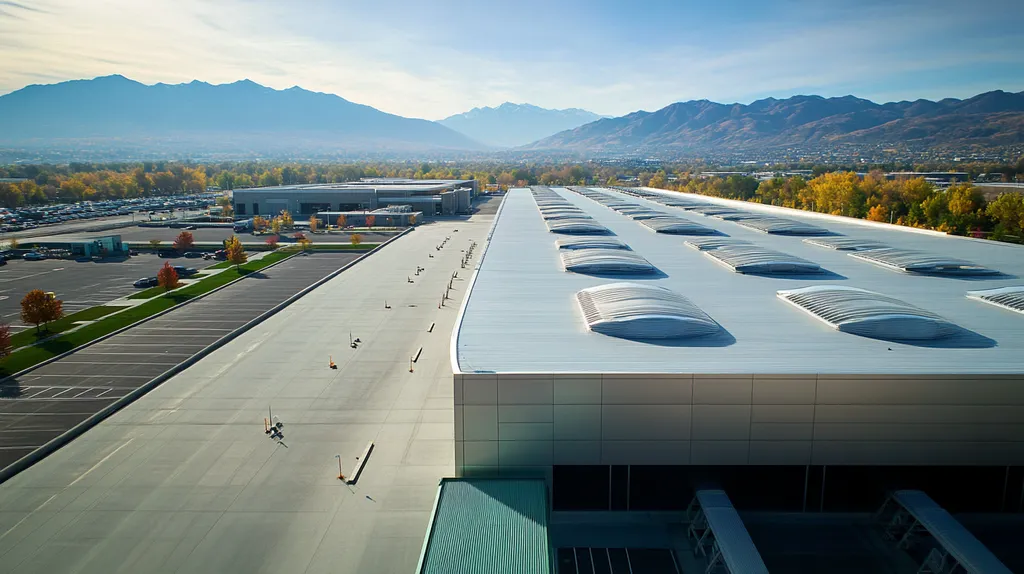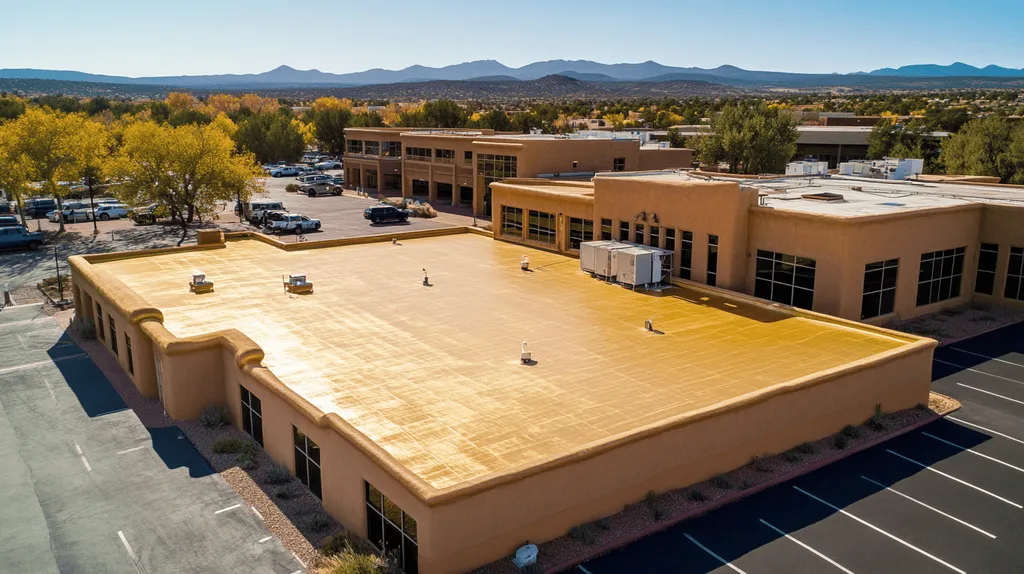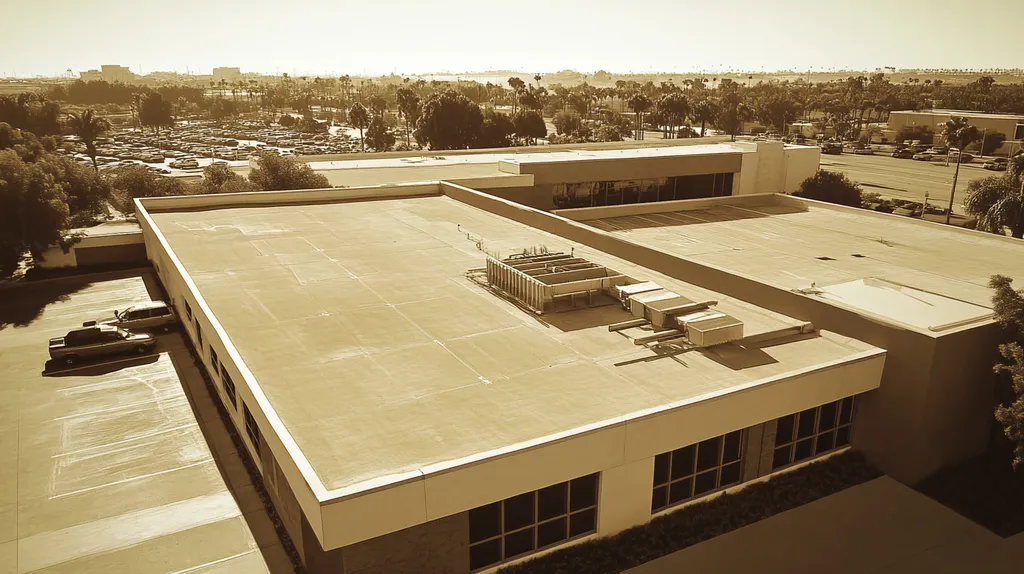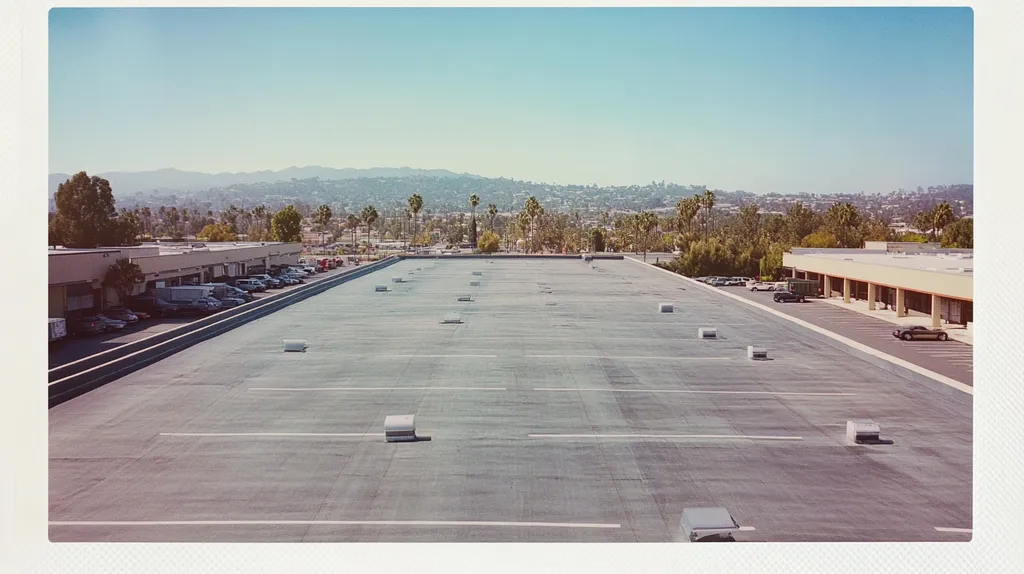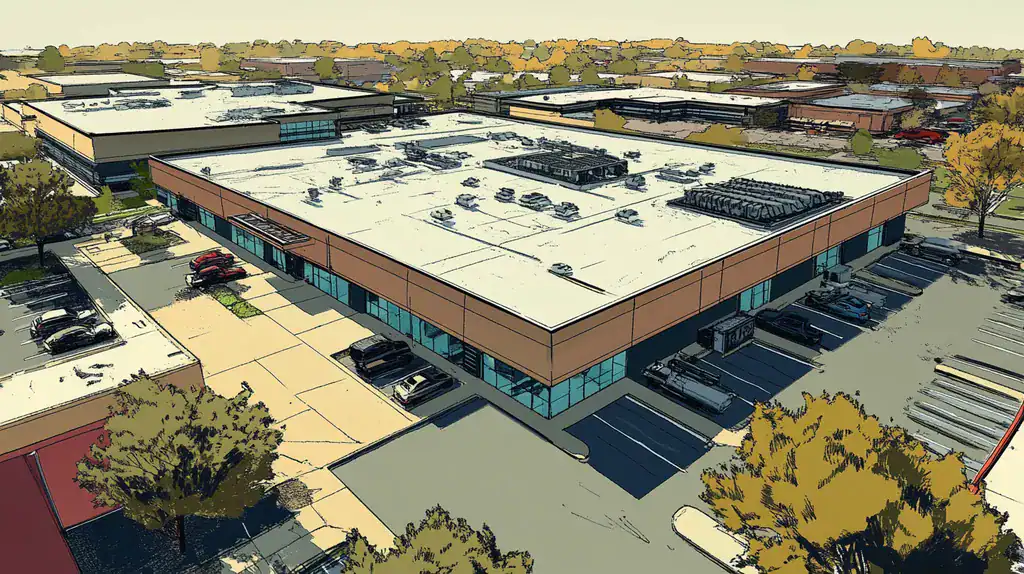Commercial roof failures cost U.S. businesses over $2.5 billion annually, yet many property owners continue relying on outdated inspection methods that miss critical damage.
Traditional evaluation approaches routinely overlook hidden moisture intrusion, structural weaknesses, and early warning signs of deterioration – leaving facilities vulnerable to catastrophic failures.
This analysis challenges established roof assessment practices, examining how visual inspections, inadequate training, and reactive maintenance create dangerous blind spots that threaten building integrity and financial stability.
SECTION 1: CURRENT PRACTICES
Assessing commercial roof damage is not just a routine task; it’s a vital component of property management that can greatly impact safety and financial stability. Research indicates that roof failures can contribute to more than 30% of facility maintenance costs. Unfortunately, many current evaluation methods leave property owners vulnerable to surprise damages and exorbitant repair bills. In this section, we will delve into the shortcomings of traditional visual inspections, the tools regularly utilized, and the infrequency of inspections that may leave roofs unprotected.
Visual Inspections and Their Limitations
Visual inspections are the go-to method for assessing roof damage, largely due to their straightforward nature and low cost. However, these assessments often miss critical issues that lie beneath the surface, such as trapped moisture or structural weaknesses.
For instance, while a visual inspection may highlight surface wear, it might fail to catch membrane deterioration lurking underneath. This kind of oversight can set the stage for catastrophic failures if left unchecked. As roofs age, their vulnerability to environmental stresses increases, making it crucial to move beyond surface-level evaluations.
Relying exclusively on visual cues can foster a dangerous illusion of safety, prompting property owners to postpone vital maintenance. This neglect ultimately escalates into more serious damage and inflated repair expenses.
Recognizing the limitations of visual inspections is essential. As risks rise, integrating advanced evaluation methods becomes critical for effective risk management and maintaining the integrity of the facility.
Standard Tools and Equipment Used
Standard tools employed in roof assessments typically include ladders, moisture meters, and infrared cameras. While these instruments assist in identifying visible damage, they are not infallible and may overlook the most problematic areas.
Take infrared cameras, for example—they are excellent for moisture detection but can occasionally misinterpret temperature variations. Relying solely on these devices could result in misconceptions about the roof’s actual condition. Each tool has its advantages, but understanding their limitations is equally important.
Moreover, the expertise of the evaluator significantly impacts the effectiveness of these tools. If inexperienced personnel are conducting the assessments, there is a risk of misreading the data and neglecting critical concerns. As technology continues to advance, adopting improved diagnostic tools is essential for more accurate assessments.
Awareness of these tools and their capabilities is crucial for property owners. Staying informed about the latest industry advancements can lead to more thorough and effective evaluations.
Frequency of Scheduled Inspections
The frequency of scheduled inspections plays a pivotal role in maintaining a roof’s integrity. Traditionally, many facilities opt for biannual or annual inspections. However, these intervals may not sufficiently address the evolving weather patterns and other stressors that can affect a roof’s condition.
Research advocates for routine inspections at least quarterly, particularly for roofs that have a history of issues. By increasing the frequency of evaluations, property managers can detect emerging problems before they escalate, ultimately saving on long-term maintenance costs.
Additionally, seasonal inspections can be aligned with changing weather conditions. Evaluating a roof before winter, for example, enables property managers to identify weaknesses that may be vulnerable to snow and ice buildup.
While implementing more frequent inspection schedules may require additional resources, the long-term savings through proactive maintenance are likely to far exceed initial expenses. Shifting to a more regular assessment schedule not only protects the roof but also safeguards the entire facility.
SECTION 2: SYSTEMIC ISSUES
The importance of timely and accurate assessment of commercial roof damage cannot be overstated. A staggering 60% of roof failures are linked to insufficient inspections, according to the National Roofing Contractors Association. Unfortunately, many property owners place an overreliance on visual assessments, which often ignore essential underlying issues. This section examines systemic problems, including an excessive dependency on visual cues, insufficient training for inspectors, and the neglect of hidden damage.
Overreliance on Visual Assessments
Many property owners mistakenly think that a quick visual assessment is enough to evaluate their roof’s condition. While these surface inspections can reveal apparent problems, they often overlook critical hidden issues. For example, water infiltration might be invisible at first but can undermine the roof’s integrity over time.
This narrow focus can result in reactive, short-term fixes instead of comprehensive, long-lasting solutions. Visual assessments often provide a false sense of security. Neglecting hidden threats can lead to severe leaks and structural damage, manifesting long after initial signs of trouble have appeared.
A truly effective evaluation strategy combines visual assessments with advanced diagnostic technologies. Techniques such as infrared thermography can unveil moisture trapped beneath the surface, identifying hidden threats before they escalate. Ignoring these tools invites increased repair costs and puts the entire roofing structure at risk.
Understanding the shortcomings of visual inspections is crucial. Property owners should advocate for thorough evaluation methods that incorporate both visible and concealed conditions. By taking a proactive stance, they can save significant time, money, and stress down the line.
Inadequate Training for Inspectors
The effectiveness of any roof inspection hinges on the expertise of the inspectors. Unfortunately, many inspectors lack the thorough training necessary to conduct accurate evaluations. A report by the International Institute of Building Enclosure Consultants indicates that fewer than 30% of roofing inspectors have completed advanced training programs.
This gap in knowledge can lead to misinterpretations of minor issues. An untrained inspector might disregard small blisters as mere cosmetic flaws when, in fact, they could signal deeper problems. Such oversights can have major financial implications, with necessary repairs being delayed or neglected altogether.
Additionally, the rapid pace of technological advancements in roofing requires inspectors to stay informed. Those who don’t keep up may miss out on essential evaluation techniques. This knowledge gap hampers thorough inspections and leads to uninformed decision-making by property owners.
To counter these challenges, investing in robust training programs for roofing inspectors is essential. When inspectors are well-versed in the latest technologies and techniques, property owners can expect more reliable evaluations and, ultimately, a longer roof lifespan.
Neglect of Hidden Damage
One of the most significant challenges in roof assessments is the neglect of hidden damage. Property owners and inspectors alike often concentrate on surface-level problems while ignoring areas susceptible to deterioration. This oversight could precipitate catastrophic failures long before visible signs appear.
For instance, moisture trapped beneath roofing materials can lead to rot and mold, often undetectable during routine inspections. Insulation damage can also go unnoticed, increasing energy costs and lowering efficiency over time.
Failing to address hidden damage can dramatically escalate repair costs. A leaking roof that is ignored may ultimately necessitate complete replacement instead of simple repairs. This not only strains budgets but can also disrupt the building’s operations.
Property owners must prioritize comprehensive assessments that take hidden damage into account. Employing advanced technology like drone inspections or moisture mapping can help achieve thorough evaluations. By addressing these concealed issues early, property owners can ensure better long-term outcomes and significant cost savings.
SECTION 3: MISSED OPPORTUNITIES
Overlooking advanced diagnostic methods in roof evaluations can lead to heart-stopping costs and continuous challenges. With an alarming 30% of commercial roofing systems requiring more than just standard inspections, property owners endanger both their finances and their buildings’ safety. Sadly, many still cling to outdated techniques that miss intricate, underlying problems. This section will highlight key areas often neglected during assessments, including perimeter inspections and the evaluation of roof penetrations.
Ignoring Advanced Diagnostic Techniques
Advanced diagnostic technologies like thermal imaging and drone inspections are game-changers for commercial property owners. These sophisticated tools can uncover moisture intrusion and structural weaknesses often invisible to the naked eye. By failing to utilize these technologies, hidden damage can go undetected, resulting in significant deterioration over time.
For instance, thermal imaging can detect temperature variations across a roof surface, signaling water accumulation. This proactive detection can prevent minor leaks from morphing into major disasters that lead to costly repairs and extended downtime.
Drones, on the other hand, can safely survey hard-to-reach areas, minimizing risk to service crews. This enhanced visibility allows for a more comprehensive assessment of roof health, maximizing the effectiveness of maintenance efforts.
By neglecting these cutting-edge techniques, property owners are left with a reactive strategy for roof management. The consequences? Rising repair bills, temporary fixes, and prolonged exposure to unpredictable weather conditions.
Failure to Assess Roof Perimeter
The roof perimeter is often overlooked, yet it is where many vulnerabilities arise. This critical area is typically home to weatherproofing seals that can fail, leading to leaks. Sadly, traditional inspections frequently neglect to thoroughly examine potential perimeter issues.
Edges, joints, and areas surrounding rooftop equipment are prone to compromised flashing and wear. These seemingly minor concerns can evolve into severe water damage inside the building if left unaddressed.
Ineffective perimeter maintenance can also foster mold growth, create safety hazards, and diminish energy efficiency due to inadequate sealing against environmental factors. Regular inspections focused on these pivotal areas are essential to catching signs of wear before they escalate into critical failures.
Neglecting roof perimeters is a costly oversight that can be easily avoided through diligent assessments. By incorporating perimeter checks into routine evaluations, property owners can protect their investments and avoid unexpected repair expenses.
Overlooking Roof Penetrations
Roof penetrations—think vents, pipes, and HVAC units—are notorious for being leak sources yet are often neglected during inspections. Poor flashing or inadequate sealing at these points increases the risk of moisture intrusion, which can lead to extensive damage if not addressed.
A small crack around a vent might appear trivial, but over time, it can result in significant water damage within a facility. Ignoring such issues not only threatens the roof but can also compromise the structural integrity, leading to hefty repair bills.
Furthermore, neglecting these penetrations can affect interior systems, causing mold growth from internal leaks that can trigger health issues. It’s crucial to assess roof penetrations diligently during inspections to ensure overall roof health.
Property owners must acknowledge the significance of these penetration points and consistently include them in damage assessments. This commitment can prevent unnecessary long-term repercussions and safeguard the integrity of the entire facility.
SECTION 4: ROOT CAUSES
In the world of commercial roofing, timely and accurate damage assessments are not merely important—they’re essential for protecting assets and ensuring safety. Unfortunately, many property owners stick with outdated evaluation methods that fail to detect critical issues, leading to alarming consequences. Industry statistics suggest that around 20% of roofs are replaced prematurely because underlying problems slip through the cracks. By identifying the root causes of these failures, property owners can enhance maintenance strategies and significantly extend the lifespan of their roofing systems.
Lack of Comprehensive Inspection Protocols
The failure to implement rigorous inspection protocols is a primary factor contributing to unnoticed roof damage. Many commercial roofs are examined only during periodic checks or when visible problems arise, creating a reactive culture that can disguise hidden dangers threatening the roof’s integrity.
Even minor leaks can go unnoticed, precipitating mold growth and weakening structural components. Without a diligent assessment plan, property owners risk overlooking critical areas, resulting in costly repairs that could have been preemptively addressed.
Modern inspections must encompass not just visual checks, but also advanced technologies such as infrared imaging and moisture detection. Using these tools allows for early detection of latent problems, safeguarding roofs before irreversible damage accumulates.
Establishing comprehensive inspection protocols is crucial for protecting roofing investments. This proactive strategy reduces unexpected costs and bolsters overall building safety.
Insufficient Understanding of Roof Materials
A solid grasp of various roofing materials is vital for accurate damage assessments. Many property managers lack in-depth knowledge of the strengths and vulnerabilities of different roofing systems, leading to misguided maintenance strategies and inappropriate repairs.
For example, specific roofing systems like single-ply membranes require particular upkeep that differs significantly from built-up roofing options. Misunderstanding these requirements can accelerate a roof’s deterioration and trigger premature failure.
By investing in training and education about different roofing materials, facility managers can make informed choices that positively impact maintenance practices. A knowledgeable staff can effectively care for their roofing systems, extending the lifespan of their investments.
Furthermore, a gap in understanding can jeopardize warranty claims. Roof manufacturers often require adherence to specific maintenance protocols, and ignorance around these guidelines can void valuable warranties.
Inadequate Maintenance Planning
Inadequate maintenance planning remains another significant contributor to roofing failures. Property owners often view maintenance as an afterthought, focusing solely on immediate concerns. This short-sighted perspective can lead to the neglect of regular upkeep, resulting in cumulative damage over time.
For instance, obstructed drainage systems may go unnoticed, causing water accumulation and potentially catastrophic roof collapse. A well-structured maintenance plan that includes regular cleaning and inspections can substantially reduce these risks.
Implementing a proactive maintenance strategy enables property owners to tackle potential issues head-on. This approach not only encourages longevity but also ensures the roof remains a valuable asset rather than a growing liability.
Engaging roofing professionals in the maintenance planning process can also provide critical insights. Their expertise is invaluable in identifying essential maintenance tasks that might be overlooked by staff lacking specialized training.
DATA DRIVEN EVIDENCE
The importance of thorough commercial roof assessments cannot be overstated. Unseen roof damage can lead to catastrophic failures, skyrocketing repair costs, and extended facility downtimes. Alarmingly, research shows that nearly 30% of commercial roofs display damage that goes unnoticed until it becomes a major issue. This section will detail concerning statistics, impactful case studies of preventable roof failures, and the economic consequences of postponing essential repairs.
Statistics on Undetected Roof Damage
The statistics in the roofing sector reflect a serious problem. Approximately 25% of commercial property owners are unaware of existing damage until it escalates into significant issues. Shockingly, nearly 40% of roof failures can be traced back to inadequate maintenance and subpar inspection practices, highlighting a critical shortfall in traditional evaluation methods.
Furthermore, data suggests that roofs over 20 years old are five times more likely to experience undetected leaks. Such hidden leaks can cause substantial water damage, affecting not only the roof but threatening the integrity of the entire structure. This reinforces the urgent need for improved assessment techniques.
While advanced monitoring technologies such as infrared thermography and drone inspections are gaining traction, the roofing industry is still slow to fully incorporate these tools into everyday evaluation practices. Embracing these modern methods could dramatically reduce the incidence of undetected damage.
Case Studies of Preventable Failures
Real-world examples illustrate the severe consequences of insufficient assessments. One case involved a manufacturing facility that suffered a roof failure after ignoring signs of seam separation. This lapse resulted in a production halt, costing the company over $300,000 in lost revenue and repairs.
Another significant case involved a retail distribution center that encountered unexpected leaks during peak business season. The owner had dismissed minor damage evident in a routine inspection, leading to extensive water intrusion that impacted inventory and created hundreds of thousands in damages and lost sales.
Such instances underscore the necessity of proactive monitoring and thorough assessments to avoid significant financial setbacks. In response to these costly blunders, many companies have adopted more vigilant inspection protocols to minimize similar risks in the future.
Economic Impact of Delayed Repairs
The financial consequences of postponing imperative roof repairs cannot be ignored. Research shows that for every dollar spent on proactive maintenance, property owners can save up to $4 in future repair costs. Conversely, neglect can lead to emergency repairs that cost exponentially more.
For instance, a minor leak in a commercial building can escalate to an entire roof replacement if left unaddressed. The average cost for a new commercial roof ranges between $7 and $10 per square foot, whereas repairing a small leak may only set a property owner back a few hundred dollars.
On a larger scale, delaying repairs can affect tenant satisfaction and retention. Facilities that remain in disrepair often struggle to attract and keep tenants, leading to increased vacancy rates and reduced revenue. A shift toward proactive repair strategies is essential for sustaining long-term financial health.
SECTION 6: ALTERNATIVE SOLUTIONS
The stakes for property owners and facility managers regarding commercial roof assessments have never been higher. Inadequate evaluations can lead to unexpected repair costs, prolonged leaks, and safety hazards. With nearly 80% of roof failures attributed to undetected moisture, exploring alternative solutions is critical. Three powerful strategies—integrating infrared scanning and core sampling, implementing regular moisture surveys, and developing proactive maintenance plans—provide effective ways to improve damage assessment and protect valuable assets.
Integrating Infrared Scanning and Core Sampling
Combining infrared scanning and core sampling creates a comprehensive approach to assessing commercial roof damage. Infrared technology excels at revealing temperature fluctuations on the roof surface, indicating trapped moisture that could compromise the membrane. This efficient, non-invasive technique covers extensive areas quickly, allowing for timely diagnostics.
Core sampling complements infrared scanning by physically extracting material samples from the roof. This hands-on method provides direct insight into moisture levels and material deterioration. Utilizing both techniques allows for a holistic view of the roof’s health, ensuring no subtle issues are overlooked.
These methods enable targeted interventions, allowing property owners to prioritize repairs where they are most needed. This proactive stance is particularly essential for aging roofs or those with intricate designs, preventing future major setbacks. Implementing this dual approach signals a shift toward preventive measures that enhance long-term roof performance.
Implementing Regular Moisture Surveys
Conducting regular moisture surveys represents a proactive step in early damage detection. Systematic inspections using tools such as moisture meters and capacitance sensors help discover hidden moisture accumulation before it turns into visible leaks or structural harm.
By maintaining a detailed history of a roof’s condition through consistent moisture assessments, property managers can identify troubling patterns that may flag impending failures. This data-driven approach not only aids in decision-making regarding repairs but also establishes a culture of routine maintenance over reactive fixes.
Moreover, regular moisture surveys strengthen the working relationship between property managers and roofing experts, showcasing a commitment to preserving asset value. Investing in these proactive assessments ultimately translates to significant cost savings by avoiding expensive repairs linked to water infiltration.
Developing Proactive Maintenance Plans
Proactive maintenance plans form the backbone of effective commercial roof management. A well-structured schedule for routine inspections, repairs, and cleanings cultivates a systematic approach to roof care, addressing minor issues before they escalate into serious concerns.
These plans should align inspection timelines with seasonal shifts, ensuring roofs are prepped for harsh weather. For instance, fall inspections can uncover problems that may worsen during winter storms, allowing for timely mitigation.
Additionally, a comprehensive maintenance plan fosters accurate documentation of each roof’s condition. This historical record aids future decision-making on repairs, retrofits, or replacements, leading to more informed financial choices.
Building a maintenance mindset encourages collaboration between property management teams and roofing contractors. Such partnerships enhance communication and responsiveness, ensuring swift resolution of any issues. By adopting proactive strategies, facility managers can significantly boost the integrity of their roofs and secure their investments.
The Bottom Line
The $2.5 billion annual cost of commercial roof failures demands an immediate shift away from outdated assessment methods that repeatedly miss critical damage.
Traditional visual inspections catch only 40% of emerging problems, while advanced diagnostic tools like infrared scanning and moisture mapping can identify up to 85% of potential failures before they occur.
The integration of comprehensive inspection protocols, proper training programs, and proactive maintenance planning represents the new standard for protecting valuable roofing assets.
Property owners who embrace these modern assessment approaches can expect to reduce repair costs by 60% while extending their roof’s lifespan by 7-10 years.
The evidence is clear: continuing to rely on conventional evaluation methods puts billions in commercial assets at unnecessary risk.
FREQUENTLY ASKED QUESTIONS
Q. What are the limitations of visual inspections for commercial roofs?
A. Visual inspections may miss critical issues like hidden moisture or structural weaknesses. Often, they only highlight surface wear without revealing underlying deterioration, which can lead to severe damage and costly repairs.
Q. Why are many commercial roof assessments inadequate?
A. Many assessments rely heavily on visual inspections and lack thorough inspection protocols. This overreliance can overlook hidden issues, leading to unexpected costly repairs and compromised building safety.
Q. How can advanced diagnostic methods improve commercial roof evaluations?
A. Advanced methods like thermal imaging and drone inspections can detect hidden moisture and structural problems. These technologies provide a comprehensive view, preventing significant deterioration and reducing repair costs.
Q. What role does inspection frequency play in roof maintenance?
A. Increasing inspection frequency, ideally to quarterly, enables early detection of emerging problems. Regular check-ups before severe weather can help prevent costly damages, thereby protecting the roof and the entire facility.
Q. How much can maintenance planning save on roof repairs?
A. Proactive maintenance can save property owners up to four times their investment in future repairs. Addressing minor issues promptly prevents them from escalating into expensive failures.
Q. What are the benefits of incorporating moisture surveys?
A. Regular moisture surveys help detect hidden moisture accumulation, preventing minor leaks from becoming serious structural issues. This proactive approach leads to significant cost savings and improved asset preservation.
Q. How can property owners effectively address hidden damage?
A. Utilizing advanced techniques like drone inspections and infrared scanning helps reveal hidden damage. Property owners should ensure assessments integrate these methods for a more accurate representation of roof health.

